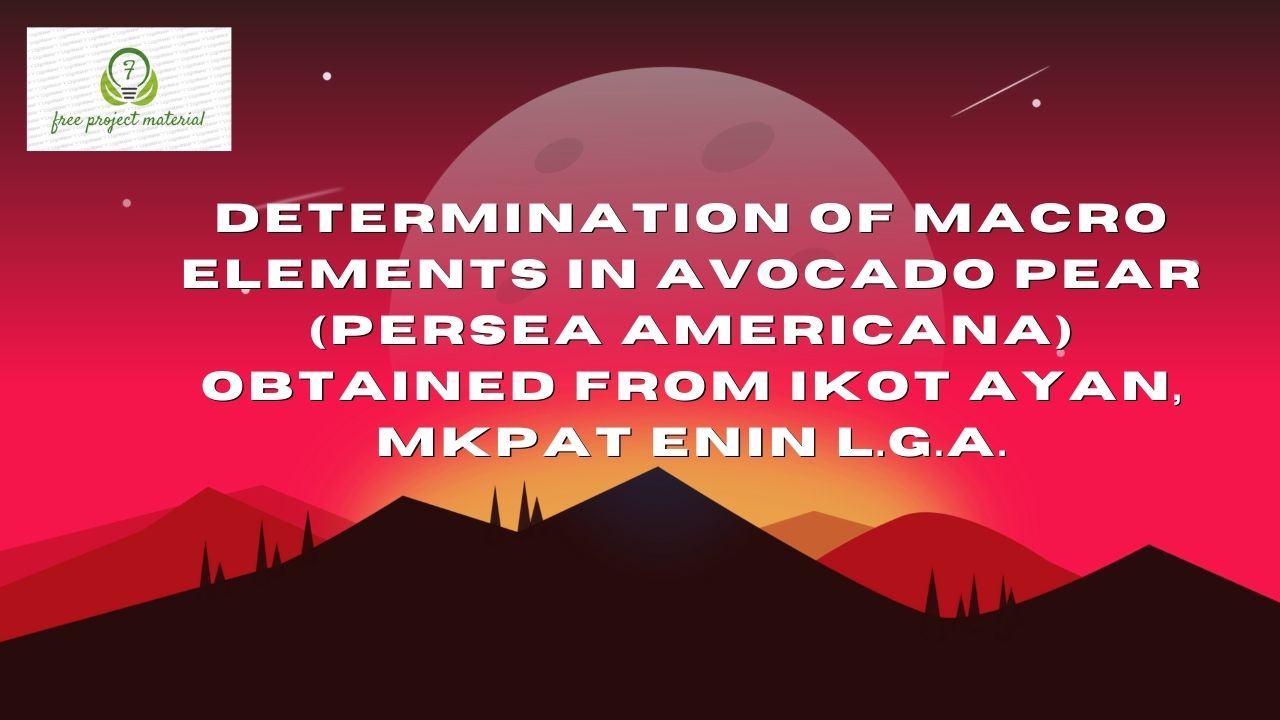ABSTRACT
This study on the macro-mineral composition of avocado pear was carried out using standard analytical method, the result of this study revealed the following. Calcium (Ca) (1.215±0.0084mg /100g), magnesium (Mg) (1.405±0.005mg/100g), potassium (K) (49.233±0.0035mg/100g), sodium (Na) (37.108±0.0056) and phosphorous (P)(69.404±0.0028). This result revealed that avocado pear contains important mineral element needed for proper functioning of the body, although they are not sufficient amount as such it is recommended that avocado pear should be used as supplement in order to improve the mineral composition of food substances.
TABLE OF CONTENTS
Title page- – – – – – – – – – i
Certification- – – – – – – – – ii
Dedication- – – – – – – – – – iii
Acknowledgements- – – – – – – – iv
Abstract- – – – – – – – – – vi
Table of contents- – – – – – – – – vii
CHAPTER ONE: INTRODUCTION
1.1 Background of the study- – – – – – – 1
1.2 Aim and objective of the study- – – – – – 3
1.3 Scope and Limitation of the study- – – – – 3
CHAPTER TWO: LITERATURE REVIEW
2.1 Description of Avocado- – – – – – – 4
2.2 Origin of Avocado- – – – – – – 6
2.3 Nutritional value and Health Benefits of Avocado- – – 6
2.4 Chemical composition of Avocado- – – – – 8
2.5 Factors affecting the concentration and availability
of mineral elements in plants- – – – – – 9
2.6 Macro-mineral Elements- – – – – – 13
2.6.1 Calcium- – – – – – – – – 13
2.6.2 Phosphorus – – – – – – – 15
2.6.3 Sodium- – – – – – – – – 16
2.6.4 Potassium- – – – – – – – – 16
2.6.5 Magnesium – – – – – – – – 18
CHAPTER THREE: MATERIALS AND METHODS
3.1 Materials- – – – – – – – – 21
3.2 Methods- – – – – – – – – 21
3.2.1 Sample Collection and Preparation- – – – – 21
3.2.2 Sample Digestion- – – – – – – – 21
3.2.3 Determination of Macro-Mineral Elements- – – – 22
CHAPTER FOUR: RESULTS AND DISCUSSION
4.1 Results- – – – – – – – – 24
4.2 Discussion- – – – – – – – – 25
CHAPTER FIVE: CONCLUSION AND RECOMMENDATIONS
5.1 Conclusion- – – – – – – – – 28
5.2 Recommendations- – – – – – – 28
References
CHAPTER ONE: INTRODUCTION
1.1 Background of the study
The avocado (Persea americana) belongs to the lauraceae family of tropical and mediterrnian trees and shrubs, other members of this family include: laurel, cinnamon, saffras and green-heart (a timber of the Guianas). The English name is derived from the Spanish word ‘abogado’, which was avocet in French. The avocado is thought to have originated from Mexico and Central and South America, for thousands of years and till today, it has been a popular food in those places. The avocado is one of the fruits with an excellent nutritional quality. It has low sugar content, this makes avocado very recommendable source of high energy food for those who are diabetic. The avocado is highly consumed in the world due to the presence of unsaturated lipids and its relevance in improving and maintaining healthy heart and circulatory system. Several studies have focused on the composition of avocado.
The oil content of the fruit depends upon its ecological origin and on the cultivar, as for example, in evatemalan and Mexican cultivars, the oil content varies from 10 to 13% and from 15 to 25%, respectively (Biale and Young, 1971). While in the fruits from Caribbean, a low fat (2.5 to 5%) has been reported (Hatton et al., 1964). Adulteration of olive oil with avocado oil to a level of 35% is undetectable on the basis of the flavor as the avocado oil possesses (trace) elements. The macro-minerals include calcium, phosphorus, sodium, magnesium and potassium, while the macro-elements include iron, copper, cobalt, chloride, iodine, zinc, manganese, molybdenum, fluoride, chromium, selenium and sulfur (Eruvbetine, 2003). The macro-minerals are required in amounts greater than 100 mg/dl and the micro-minerals are required in amounts less than 100 mg/dl (Murray et al., 2000). The ultra-trace elements include boron, silicon, arsenic and nickel which have been found in animals and are believed to be essential for those animals. Evidence for requirements and essentialness of others like cadmium, lead, tin lithium and vanadium is weak (Albion Research Notes, 1996).
The mineral elements are separate entities from the other essential nutrients like proteins, fats, carbohydrates, and vitamins. Animal husbandry had demonstrated the need for minerals in the diet (Hegsted et al., 1976). In this century, biological assay methods clarified the significance and importance of mineral elements for human and animal nutrition and modern analytical techniques led to the detection of trace elements as essential nutrients and this is still an active area of current research.
1.2 Aim and Objectives of the study
The aim of this study is to determine the macro elements composition of avocado pear.
The specific objectives of this study are:
To determine the sodium content in Avocado pear
To determine the magnesium content in Avocado
To determine the calcium content in Avocado pear
To determine the phosphorus content in Avocado pear
To determine the potassium content in Avocado pear
1.3 Scope and Limitations of the study
This study focuses only on the determination of macro elements in Avocado pear due to time and financial constraint.


